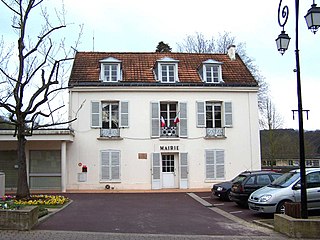
Yvelines is a department in the western part of the Île-de-France region in Northern France. In 2019, it had a population of 1,448,207. Its prefecture is Versailles, home to the Palace of Versailles, the principal residence of the King of France from 1682 until 1789, a UNESCO World Heritage Site since 1979. Yvelines' subprefectures are Saint-Germain-en-Laye, Mantes-la-Jolie and Rambouillet.

Jules Hardouin-Mansart was a French Baroque architect and builder whose major work included the Place des Victoires (1684–1690); Place Vendôme (1690); the domed chapel of Les Invalides (1690), and the Grand Trianon of the Palace of Versailles. His monumental work was designed to glorify the reign of Louis XIV of France.

Seine-et-Oise is a former department of France, which encompassed the western, northern and southern parts of the metropolitan area of Paris. Its prefecture was Versailles and its administrative number was 78. Seine-et-Oise was disbanded in 1968 as part of the reorganisation of the departments of the Paris metropolitan area. The newly created Yvelines department inherited the 78 number.

The Château de Marly was a French royal residence located in what is now Marly-le-Roi, the commune on the northern edge of the royal park. This was situated west of the palace and garden complex at Versailles. Marly-le-Roi is the town that developed to serve the château, which was demolished in 1806 after passing into private ownership and being used as a factory. The town is now a bedroom community for Paris.

Louveciennes is a commune in the Yvelines department in the Île-de-France region in north-central France. It is located in the western suburbs of Paris, between Versailles and Saint-Germain-en-Laye, and adjacent to Marly-le-Roi.

The arrondissement of Saint-Germain-en-Laye is an arrondissement of France in the Yvelines department in the Île-de-France region. It has 44 communes. Its population is 524,951 (2019), and its area is 350.9 km2 (135.5 sq mi).

The arrondissement of Versailles is an arrondissement of France in the Yvelines department in the Île-de-France region. It has 23 communes. Its population is 417,560 (2019), and its area is 187.2 km2 (72.3 sq mi).
Hunting Lodge or Hunting lodge may refer to:

Jean-François-Thérèse Chalgrin was a French architect, best known for his design for the Arc de Triomphe, Paris.

The autoroute A14 is an autoroute in the western suburbs of Paris, France. It connects the business district of La Défense, at Nanterre (Hauts-de-Seine), to Orgeval (Yvelines) where it joins the A13. Its operation is managed by the Sanef group.

Chambourcy is a commune in the Yvelines department in the Île-de-France region in north-central France. It is located 3 km (1.9 mi) west of Saint-Germain-en-Laye and about 25 km (16 mi) west of Paris.

Buc is a commune in the Yvelines department and Île-de-France region of north central France.

The Forêt de Marly is a 2000 hectare forest estate in Yvelines, between Saint-Germain-en-Laye and Versailles about 15 km to the west of Paris. It is about 12 km long east to west, over the communes of Louveciennes, Marly-le-Roi, Saint-Nom-la-Bretèche, Feucherolles and others. Historically, it was a hunting estate of the kings of France, then of the presidents of the Republic, but is now divided along its whole length by the A13 autoroute.

The Pavilion du Butard is a hunting lodge in the Forêt de Fausses-Reposes in the territory of La Celle-Saint-Cloud in Yvelines, France. Part of the gardens of Versailles, it was designed by Ange-Jacques Gabriel for Louis XV and built between 1750 and 1754. It was made state property on 27 June 1794 by François-Nicolas Périgon, notary at Paris, during the French Revolution. On 23 April 1802 it became the property of empress Joséphine de Beauharnais, who wished to merge it with her Malmaison estate, but it returned to being state property on her divorce from Napoleon in 1809. It was later also enjoyed by Charles X of France and emperor Napoleon III of France. It was occupied by the Prussians during the Franco-Prussian War. Still state property, it was made a monument historique on 29 August 1927. In 2019, the pavilion is the subject of interest from the Centre des Monuments Nationaux, with a view to a hypothetical purchase.

A Jagdschloss is a hunting lodge in German-speaking countries. It is a schloss set in a wildlife park or a hunting area that served primarily as accommodation for a ruler or aristocrat and his entourage while hunting in the area.

In Renaissance and Early Modern German architecture, a Lustschloss is a country house, château, or palace which served the private pleasure of its owner, and was seasonally inhabited as a respite from court ceremonies and state duties. In France, the Château de Madrid in the Bois de Boulogne, easily reached from Paris, arguably set an example, and Louis XIV similarly holidayed annually from the Palace of Versailles to his nearby Château de Marly, and more frequently used his Grand Trianon, to which the Petit Trianon was added in the following century.

Eugène Louis Millet was a French architect. He planned and began the restoration of the Château de Saint-Germain-en-Laye, home of the Museum of National Antiquities.

The Cour Carrée is one of the main courtyards of the Louvre Palace in Paris. The wings surrounding it were built gradually, as the walls of the medieval Louvre were progressively demolished in favour of a Renaissance palace.

The Paris Avenue is a thoroughfare in Versailles, France.





























